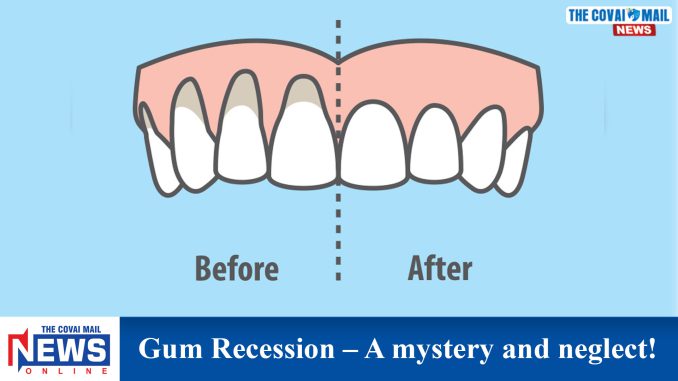
A pleasant smile is considered to be the symbol of beauty and well-being in modern society with dental esthetics being an integral part of it. The gingival perspective of esthetics is more often concerned with the soft tissue envelope surrounding the teeth.

Gum recession / receding gums is the exposure of the tooth roots due to apical shift of the gingival margin attributed to aggressive & faulty tooth brushing, poor oral hygiene with food deposits (calculus & tartar), crooked/ malpositioned teeth, smoking, uncontrolled diabetes, grinding & tooth clenching, trauma, self-inflicted injuries, lip/tongue piercing, hormonal changes and age-related factors. A greater proportion of people are unaware of this condition as it progresses gradually. The first sign of such a condition is tooth sensitivity, bleeding gums or one may notice a tooth longer than usual. These exposed root surfaces besides being unaesthetic causes additional problems like root caries and abrasions.
Dr. Nivethitha Krishnamoorthy, MDS, Consultant Periodontist & Implantologist, PSG Institute of Medical Sciences & Research provides us with further insights on what gum recession is, the treatment availability and the ways to prevent it.
Gum recession is not something you want to ignore!
If left untreated, the supporting tissue-bony structures of the teeth can severely be damaged and may ultimately result in tooth loss.
How is gum recession treated?
Can be treated both surgically and non-surgically. Milder form by deep cleaning over the affected area (scaling & root planing), correction of tooth brushing technique and maligned teeth. Severe form with excessive loss of bone requires gum surgery along with regenerative and reconstructive procedures like bone and soft tissue augmentation and grafting (Perioplastic procedures).
Even though receding gums are a conundrum among practitioners owing to their numerous etiologies, and various treatment modalities, it’s due to patients’ reluctance, misconceptions, fear and anxiety, these perioplastic procedures are often neglected in routine practice.
How to prevent it?
- Don’t rush when you brush!
- Brush and floss – Two minutes, two times a day!
- Whether you opt for a manual/ electric toothbrush choose one with soft nylon bristles that have blunted ends – remains effective & tends not to traumatise gums or root surfaces.
- Use gentle, circular motions to massage and clean the teeth and gums instead of a back-forth motion.
- Watch out for bleeding gums! Do not neglect!
- Need to replace your toothbrush every 3 to 4 months.
- Consult your dentist and correct your malpositioned teeth.
- Gradually quit smoking if you smoke!
- Practice a well-balanced and healthy diet! Eat and Feel good!
- Remember, “Dentistry is not expensive, but neglect is!” so, consult your dentist once in six months!



